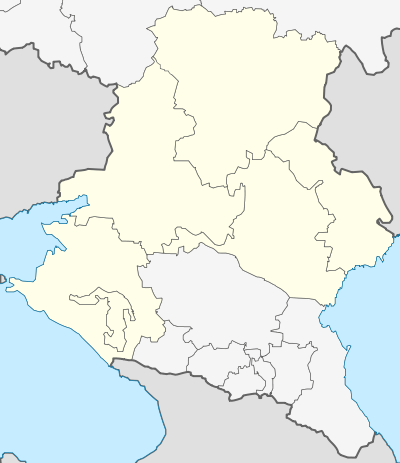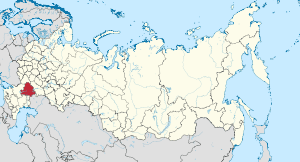Volgograd Oblast
| Volgograd Oblast Волгоградская область (Russian) | |||
|---|---|---|---|
| — Oblast — | |||
| |||
|
| |||
| |||
|
| |||
| Political status | |||
| Country | Russia | ||
| Federal district | Southern[2] | ||
| Economic region | Volga[3] | ||
| Established | December 5, 1936[4] | ||
| Administrative center | Volgograd | ||
| Government (as of August 2014) | |||
| • Governor[5] | Andrey Bocharov (acting)[6] | ||
| • Legislature | Oblast Duma[5] | ||
| Statistics | |||
| Area (as of the 2002 Census)[7] | |||
| • Total | 113,900 km2 (44,000 sq mi) | ||
| Area rank | 31st | ||
| Population (2010 Census)[8] | |||
| • Total | 2,610,161 | ||
| • Rank | 18th | ||
| • Density[9] | 22.92/km2 (59.4/sq mi) | ||
| • Urban | 76.0% | ||
| • Rural | 24.0% | ||
| Population (January 2014 est.) | |||
| • Total | 2,569,126[10] | ||
| Time zone(s) | MSK (UTC+03:00)[11] | ||
| ISO 3166-2 | RU-VGG | ||
| License plates | 34 | ||
| Official languages | Russian[12] | ||
| Official website | |||
Volgograd Oblast (Russian: Волгогра́дская о́бласть, Volgogradskaya oblast) is a federal subject (an oblast) of Russia. Its administrative center is Volgograd. The population was 2,610,161 in the 2010 Census.[8]
Geography

stan
*Smaller areas along the north Caucasus are the republics: Karachay-Cherkessia, Kabardino-Balkaria, North Ossetia-Alania, Ingushetia, and Chechnya
*Yellow is the Southern Federal District and Pink is the North Caucasus Federal District
- Borders length: 2,221.9 kilometers (1,380.6 mi)
Volgograd Oblast borders with Saratov, Rostov, Astrakhan, and Voronezh Oblasts, as well as with the Republic of Kalmykia of Russia and with Kazakhstan.
Volgograd has more than 200 rivers and streams. The major ones include:
- The Volga River
- The Don River
- The Medveditsa River
- The Khopyor River
History
Stalingrad Oblast (Сталинградская область) was established on December 5, 1936 on the territory of former Stalingrad Krai.[4] The oblast was given its present name on November 10, 1961.[4]
Administrative divisions
Politics

During the Soviet period, three people exercised oblast-level authority:
- the first secretary of the Volgograd CPSU Committee (who in reality had the most power)
- the chairman of the oblast Soviet (legislative power)
- the chairman of the oblast Executive Committee (executive power)
In 1991 the CPSU lost de facto power, and the head of the Oblast administration, and eventually the governor was appointed/elected alongside elected regional parliament.
The Charter of Volgograd Oblast provides the fundamental law of the region. The Legislative Assembly of Volgograd Oblast is the province's standing legislative (representative) body. The Legislative Assembly exercises its authority by passing laws, resolutions, and other legal acts and by supervising the implementation and observance of the laws and other legal acts passed by it. The highest executive body, the Oblast Government, includes territorial executive bodies such as district administrations, committees, and commissions that facilitate development and run the day-to-day matters of the province. The Oblast administration supports the activities of the Governor, who is the highest official and acts as guarantor of the observance of the oblast Charter in accordance with the Constitution of Russia.
Demographics
Population: 2,610,161 (2010 Census);[8] 2,699,223 (2002 Census);[13] 2,593,944 (1989 Census).[14]
- Vital statistics for 2012
2009 - 1.46 | 2010 - 1.45 | 2011 - 1.44 | 2012 - 1.54 | 2013 - 1.53 | 2014 - 1.57 | 2015 1.59(e)
Ethnic groups
(shown are the ethnic groups with a population of more than 7,500 people)
| Ethnic group | Population (in 2010)[8] | Percent |
|---|---|---|
| Russians | 2,309,253 | 90 |
| Kazakhs | 46,223 | 1.8 |
| Ukrainians | 35,607 | 1.4 |
| Tatars | 24,557 | 0.9 |
| Armenians | 27,846 | 1.1 |
| Azerbaijani | 14,398 | 0.6 |
| Germans | 10,102 | 0.4 |
| Chechen | 9,649 | 0.4 |
| Belarusians | 7,868 | 0.4 |
- 44,541 people were registered from administrative databases, and could not declare an ethnicity. It is estimated that the proportion of ethnicities in this group is the same as that of the declared group.[17]
Religion
According to a 2012 official survey[18] 54.5% of the population of Volgograd Oblast adheres to the Russian Orthodox Church, 4% are unaffiliated generic Christians, 2% are Orthodox Christian believers who don't belong to any church or are members of non-Russian Orthodox churches, 3% are Muslims. In addition, 18% of the population declares to be "spiritual but not religious", 12% is atheist, and 6.5% follows other religions or did not give an answer to the question.[18]
Government
Governor of Volgograd Oblast is Anatoliy Brovko (since 2010)
Both the flag and the coat of arms of Volgograd Oblast include an image of The Motherland Calls, an 85 meter tall statue located in Volgograd.
Economics
Primary branches of economics are agriculture, food production, heavy industry, gas and petroleum refining.
Volga Hydroelectric Station operates on the Volga River.
See also
References
Notes
- ↑ Article 10 of the Charter of Volgograd Oblast states that the oblast may have an anthem, providing a law is adopted to that effect. As of 2014, no such law is in place.
- ↑ Президент Российской Федерации. Указ №849 от 13 мая 2000 г. «О полномочном представителе Президента Российской Федерации в федеральном округе». Вступил в силу 13 мая 2000 г. Опубликован: "Собрание законодательства РФ", №20, ст. 2112, 15 мая 2000 г. (President of the Russian Federation. Decree #849 of May 13, 2000 On the Plenipotentiary Representative of the President of the Russian Federation in a Federal District. Effective as of May 13, 2000.).
- ↑ Госстандарт Российской Федерации. №ОК 024-95 27 декабря 1995 г. «Общероссийский классификатор экономических регионов. 2. Экономические районы», в ред. Изменения №5/2001 ОКЭР. (Gosstandart of the Russian Federation. #OK 024-95 December 27, 1995 Russian Classification of Economic Regions. 2. Economic Regions, as amended by the Amendment #5/2001 OKER. ).
- 1 2 3 Volgograd Oblast. Administrative-Territorial Structure, p. 3
- 1 2 Charter of Volgograd Oblast, Article 7
- ↑ Official website of Volgograd Oblast. Andrey Ivanovich Bocharov, Acting Governor of Volgograd Oblast (Russian)
- ↑ Федеральная служба государственной статистики (Federal State Statistics Service) (2004-05-21). "Территория, число районов, населённых пунктов и сельских администраций по субъектам Российской Федерации (Territory, Number of Districts, Inhabited Localities, and Rural Administration by Federal Subjects of the Russian Federation)". Всероссийская перепись населения 2002 года (All-Russia Population Census of 2002) (in Russian). Federal State Statistics Service. Retrieved 2011-11-01.
- 1 2 3 4 Russian Federal State Statistics Service (2011). "Всероссийская перепись населения 2010 года. Том 1" [2010 All-Russian Population Census, vol. 1]. Всероссийская перепись населения 2010 года (2010 All-Russia Population Census) (in Russian). Federal State Statistics Service. Retrieved June 29, 2012.
- ↑ The density value was calculated by dividing the population reported by the 2010 Census by the area shown in the "Area" field. Please note that this value may not be accurate as the area specified in the infobox is not necessarily reported for the same year as the population.
- ↑ Volgograd Oblast Territorial Branch of the Federal State Statistics Service. Оценка численности постоянного населения Волгоградской области на 1 января 2014 года и в среднем за 2013 год (Russian)
- ↑ Правительство Российской Федерации. Федеральный закон №107-ФЗ от 3 июня 2011 г. «Об исчислении времени», в ред. Федерального закона №271-ФЗ от 03 июля 2016 г. «О внесении изменений в Федеральный закон "Об исчислении времени"». Вступил в силу по истечении шестидесяти дней после дня официального опубликования (6 августа 2011 г.). Опубликован: "Российская газета", №120, 6 июня 2011 г. (Government of the Russian Federation. Federal Law #107-FZ of June 31, 2011 On Calculating Time, as amended by the Federal Law #271-FZ of July 03, 2016 On Amending Federal Law "On Calculating Time". Effective as of after sixty days following the day of the official publication.).
- ↑ Official on the whole territory of Russia according to Article 68.1 of the Constitution of Russia.
- ↑ Russian Federal State Statistics Service (May 21, 2004). "Численность населения России, субъектов Российской Федерации в составе федеральных округов, районов, городских поселений, сельских населённых пунктов – районных центров и сельских населённых пунктов с населением 3 тысячи и более человек" [Population of Russia, Its Federal Districts, Federal Subjects, Districts, Urban Localities, Rural Localities—Administrative Centers, and Rural Localities with Population of Over 3,000] (XLS). Всероссийская перепись населения 2002 года [All-Russia Population Census of 2002] (in Russian). Retrieved August 9, 2014.
- ↑ Demoscope Weekly (1989). "Всесоюзная перепись населения 1989 г. Численность наличного населения союзных и автономных республик, автономных областей и округов, краёв, областей, районов, городских поселений и сёл-райцентров" [All Union Population Census of 1989: Present Population of Union and Autonomous Republics, Autonomous Oblasts and Okrugs, Krais, Oblasts, Districts, Urban Settlements, and Villages Serving as District Administrative Centers]. Всесоюзная перепись населения 1989 года [All-Union Population Census of 1989] (in Russian). Институт демографии Национального исследовательского университета: Высшая школа экономики [Institute of Demography at the National Research University: Higher School of Economics]. Retrieved August 9, 2014.
- ↑ http://www.gks.ru/free_doc/2012/demo/edn12-12.htm
- ↑ http://www.gks.ru/wps/wcm/connect/rosstat_main/rosstat/ru/statistics/publications/catalog/doc_1137674209312
- ↑ "Перепись-2010: русских становится больше". Perepis-2010.ru. 2011-12-19. Retrieved 2012-08-13.
- 1 2 3 Arena - Atlas of Religions and Nationalities in Russia. Sreda.org
- ↑ 2012 Survey Maps. "Ogonek", № 34 (5243), 27/08/2012. Retrieved 24-09-2012.
Sources
- Волгоградская областная Дума. №1-ОД 24 февраля 2012 г. «Устав Волгоградской области», в ред. Закона №90-ОД от 10 июля 2015 г. «О внесении изменений в статью 2 Устава Волгоградской области от 24 февраля 2012 г. №1-ОД». Вступил в силу по истечении десяти дней после дня официального опубликования. Опубликован: "Волгоградская правда", №35, 29 февраля 2012 г. (Volgograd Oblast Duma. #1-OD February 24, 2012 Charter of Volgograd Oblast, as amended by the Law #90-OD of July 10, 2015 On Amending Article 2 of the Charter of Volgograd Oblast #1-OD of February 24, 2012. Effective as of the day which is ten days after the day of the official publication.).
- Исполнительный комитет Волгоградского областного Совета депутатов трудящихся. "Волгоградская область. Административно-территориальное деление на 1 июля 1968 года" (Volgograd Oblast. Administrative-Territorial Structure as of July 1, 1968). Нижне-Волжское книжное издательство. Волгоград, 1969.
External links
| Wikimedia Commons has media related to Volgograd Oblast. |
- (Russian) Official website of Volgograd Oblast
- (English) Central Eurasian Information Resource: Images of Volgograd Oblast - University of Washington Digital Collections
 |
|
|
 | |
| |
|
West Kazakhstan Province, | ||
| ||||
| | ||||
| |
|



